Information
New Archaeological Finds from Chen Family Cemetery in Inner Mongolia Released
Summary: From June to November 2016, exploration of Chen family cemetery in Naobaowan was carried out by the Institute of Cultural Relics and Archaeology of Inner Mongolia Autonomous Region. 13 tombs were cleared which were located in the south and east sides of 2
From June to November 2016, exploration of Chen family cemetery in Naobaowan was carried out by the Institute of Cultural Relics and Archaeology of Inner Mongolia Autonomous Region. 13 tombs were cleared which were located in the south and east sides of 2015 excavation area. More than 200 burial objects were unearthed. The cemetery was located in the northeast margin of Kubuqi Desert in Inner Mongolia Autonomous Region.
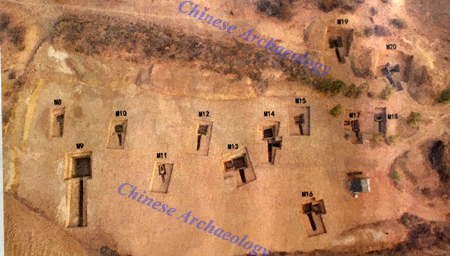
The aerial photo of the whole excavation area
13 tombs excavated from this season are all tombs with brick-chamber(s) and a sloping tomb passage. Most of them were looted. All of them are heading south. All tomb passages are sloping with a narrower southern end and a wider northern end. The vaulted passages are in different lengths with a brick-arch ceiling. The entrances and inside of it were all sealed by bricks.
Structures of tomb chambers are in various sizes, which can be divided into 4 types. The first type has a plane in the shape of Chinese character "甲" with a single brick chamber, which include 7 tombs (M8, M9, M10, M12, M15, M18 and M19). These chambers are square or rectangular in plane. Walls of some tombs are arched toward outside. Among those single brick-chamber tombs with a "甲"shaped plane, M9 has the highest rank. It's about 20m long in total. The tomb passage is 15m long and 1.6~1.7m wide. The tomb chamber is square in plane. Its top was collapsed and tomb chamber was looted, only 2 skulls and some animal bones were found. What's more, there were fragments of stone animals and figurines, ink-stones, stone epitaph and so on. The second type is boat-shaped burial (only 2 tombs M11 and M17). Chambers of those tombs are narrow and long. M11 is 5.3m long in total. Its chamber is 2m long, 0.7m~1.1m wide and 0.9m high residue. The third type contains tombs with a single side brick chamber, including M13, M16 and M20. Main chambers of M13 and M20 are square in plane, while that of M16 is square with arc sides. M13 has a side room on the west part. And M16 and M20 have a side room on the east. The fourth type is those whose tomb passages have a side brick-chamber. Only M14 belongs to this kind. It is 10.3m long. The main chamber is square in plane. There was a multiple-burial of 3 people in the main chamber and a single burial in the side room.
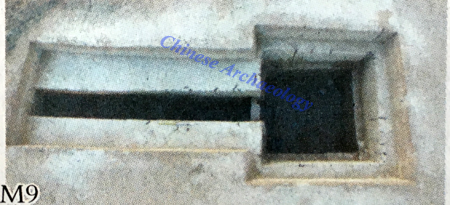
Tomb M9
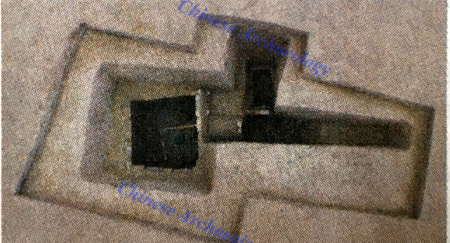
Tomb M14
Most of tomb chambers were built with bricks being constructed in stretcher bonds. Only a few chambers were built with a layer of side bricks between several layers of stretcher bonds. There were brick-paved coffin beds in the north of most square chambers. The bottoms of M14 and boat-shaped tombs (M11 and M17) were all paved by bricks, but without coffin beds. There was outline of rectangular wooden coffin left in M13. Although there were no remains of coffins in the rest of tombs, coffin nails were uncovered from most of them. The majority of the tombs are mainly in multiple-burials. Among them, there are 4 single burials, 5 double-burials, 2 multiple-burials of three people and 2 multiple-burials of four people. All of them are extended supine position burials. Skeletons from boat-shaped tombs were all heading the south, while the rest skeletons were all heading the west. The undisturbed tombs usually have coins in the mouths and hands. Animal sacrifice traces were found in a few tombs with limbs of domestic animals being buried in the tomb.
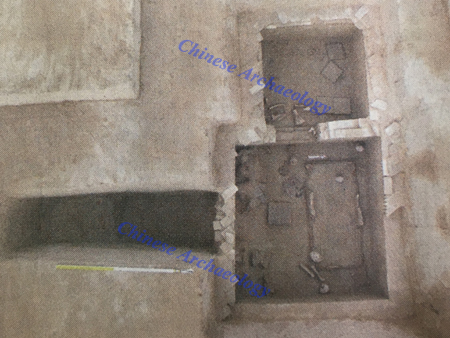
Tomb M13
Unearthed Burial Objects
Burial objects in the tomb chambers are mainly pottery bowls, pottery jars, pottery figurines, porcelain vases, lacquer plates, lacquer bowls, lacquer boxes, copper mirrors, copper belt ornaments,copper locks, copper necklaces, copper coins, iron pans, stone animals and figurines, ink-stones, stone balls, tomb stones, shells, stone epitaph and so on. Animality patrons were placed in the vaulted passage. At the entrances of chambers, there were figures of heavenly warrior kings. In the southeast of chambers, there were potteries and porcelain vessels and clay tools. Clay horses and camels were placed in the southwest corner of chambers. Besides, human figurines were placed in the south part of the chamber. There were river cobble as tomb-stones being put in the southwest corner of the chamber in varied numbers. The epitaphs were placed in southern parts of the middle of coffin beds, while only M9 has a stone-made epitaph and the rest epitaphs were made in clay.
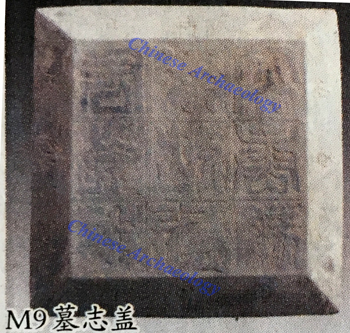
The epitagh discovered from tomb M9
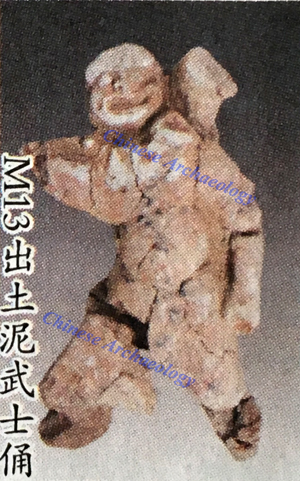
The clay warrior figurine unearthed from tomb M13
Preliminary Understandings
There were 6 epitaphs with inscriptions being uncovered in 2016. From them, it’s known that tomb owner of M20 was Chen Su from Yingchuan County. Tomb owner of M9 was Zhang Jun, who was died in the second year of Xiantian Reign (713 AD) and buried with his wife in Chen family cemetery. The inscription of M14 was rather unclear, only characters as “Yingchuan” were left and the rest were faded and indecipherable. These tombs were lined from south to north with various tomb structures and obviously varied ranks showing social status differentiations among family members. According to investigation of the cemetery, there are some other tombs of Chen family members in the periphery. Therefore, excavation works in future will shed new light on the overall look of this family cemetery. (Translator: Ma Huanhuan)

The aerial photo of the whole excavation area
13 tombs excavated from this season are all tombs with brick-chamber(s) and a sloping tomb passage. Most of them were looted. All of them are heading south. All tomb passages are sloping with a narrower southern end and a wider northern end. The vaulted passages are in different lengths with a brick-arch ceiling. The entrances and inside of it were all sealed by bricks.
Structures of tomb chambers are in various sizes, which can be divided into 4 types. The first type has a plane in the shape of Chinese character "甲" with a single brick chamber, which include 7 tombs (M8, M9, M10, M12, M15, M18 and M19). These chambers are square or rectangular in plane. Walls of some tombs are arched toward outside. Among those single brick-chamber tombs with a "甲"shaped plane, M9 has the highest rank. It's about 20m long in total. The tomb passage is 15m long and 1.6~1.7m wide. The tomb chamber is square in plane. Its top was collapsed and tomb chamber was looted, only 2 skulls and some animal bones were found. What's more, there were fragments of stone animals and figurines, ink-stones, stone epitaph and so on. The second type is boat-shaped burial (only 2 tombs M11 and M17). Chambers of those tombs are narrow and long. M11 is 5.3m long in total. Its chamber is 2m long, 0.7m~1.1m wide and 0.9m high residue. The third type contains tombs with a single side brick chamber, including M13, M16 and M20. Main chambers of M13 and M20 are square in plane, while that of M16 is square with arc sides. M13 has a side room on the west part. And M16 and M20 have a side room on the east. The fourth type is those whose tomb passages have a side brick-chamber. Only M14 belongs to this kind. It is 10.3m long. The main chamber is square in plane. There was a multiple-burial of 3 people in the main chamber and a single burial in the side room.

Tomb M9

Tomb M14

Tomb M13
Unearthed Burial Objects
Burial objects in the tomb chambers are mainly pottery bowls, pottery jars, pottery figurines, porcelain vases, lacquer plates, lacquer bowls, lacquer boxes, copper mirrors, copper belt ornaments,copper locks, copper necklaces, copper coins, iron pans, stone animals and figurines, ink-stones, stone balls, tomb stones, shells, stone epitaph and so on. Animality patrons were placed in the vaulted passage. At the entrances of chambers, there were figures of heavenly warrior kings. In the southeast of chambers, there were potteries and porcelain vessels and clay tools. Clay horses and camels were placed in the southwest corner of chambers. Besides, human figurines were placed in the south part of the chamber. There were river cobble as tomb-stones being put in the southwest corner of the chamber in varied numbers. The epitaphs were placed in southern parts of the middle of coffin beds, while only M9 has a stone-made epitaph and the rest epitaphs were made in clay.

The epitagh discovered from tomb M9

The clay warrior figurine unearthed from tomb M13
There were 6 epitaphs with inscriptions being uncovered in 2016. From them, it’s known that tomb owner of M20 was Chen Su from Yingchuan County. Tomb owner of M9 was Zhang Jun, who was died in the second year of Xiantian Reign (713 AD) and buried with his wife in Chen family cemetery. The inscription of M14 was rather unclear, only characters as “Yingchuan” were left and the rest were faded and indecipherable. These tombs were lined from south to north with various tomb structures and obviously varied ranks showing social status differentiations among family members. According to investigation of the cemetery, there are some other tombs of Chen family members in the periphery. Therefore, excavation works in future will shed new light on the overall look of this family cemetery. (Translator: Ma Huanhuan)
Category: English
News
Information
Key words:
